| Masamune Swordsmith Shop (正宗美術工芸所) |
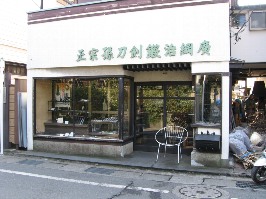
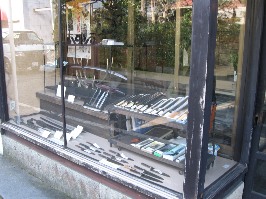
Location: One hundred meters north of the west exit of JR Kamakura Station
The shop: Masamune Bijutsu Kogeisho (正宗美術工芸所) now sells cutlery -- variety of kitchen knives, scissors, and some other cutting appliances. However the main feature is its sword-making. The owner, Yamamura Hirotsuna (山村広綱), is the 24th generation of the descendants of reputed swordsmith, Okazaki Masamune (岡崎正宗). Hirotsuna is a craftsman and makes swords with a secret technique handed down by word of mouth in his family.
Story of Masamuna: His ancestor and the first of his lineages, Masamune was a highly reputed swordsmith in the late Kamakura period. His life and career are well unknown.
There is a record stating that Masamune
was born in 1264 and died in 1344, although no months and days are known. Masamune came to Kamakura, where his father, Tozaburo Yukimitsu (藤三郎行光), an also reputed swordsmith, had his workshop. He took up his residence in the area nearby Jufukuji Temple (寿福寺). Masamune, through his unremitting efforts and rigorous training, attained the highest skill of sword making and gained a reputation as the country's foremost wordsmiths.
Most swords that are said to be his making, for reasons unknown, do not bear his name, yet are highly valued in that those swords are extremely sharp and have a unique hamon (刃文), temper pattern he created on the blades.
Story of the Masamune no I Well: Nearby is a well connected with Goro Masamune. However, the first Yamamura Tsunahiro, a descendant of Masamune and a noted swordsmith in the late Muromachi period, was more likely the well-user, for his residence was once nearby. The actual well associated with Masamune is believed to have been located near Jufukuji Temple, although the precise location has been obscured due to housing development in the area.
|
Tatsumi Jinja Shrine
(巽神社, or Tatsumi Kojin 巽荒神 ) |
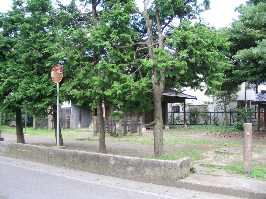
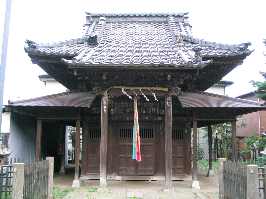
Enshrined deities: Okutsuhiko no Kami or Mikoto (奥津日子神 or 奥津彦命) and two other lesser deities. Okutsuhiko no Kami is popularly called Kojin-sama (荒神様) and is honored as the protector of kitchens and cooking fires.
Location: Three hundred meters from the west exit of JR Kamakura Station.
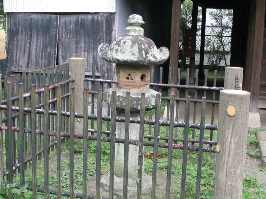 History: According to legend, in 801
during the Heian period, Sakanoue no Tamuramaro (坂上田村麻呂, 758-811), a
warrior, came to this area from Kyoto. He and his forces were on an
expedition to conquer the barbarians in the eastern part of the
country. He brought the deity to Kuzuharagaoka Hill (葛原ケ岡) and had a
shrine built there to ensure the success of his campaign.
Centuries later, Minamoto no Yoriyoshi (源頼義, 985-1078) had the shrine
repaired. In time, the temple came to be called Tatsumi Kojin (巽荒神),
because this shrine, a tutelary of Jufukuji Temple (寿福寺), was located
to the southeast of the temple. Tatsumi (巽) is the compass direction
denoting southeast.
History: According to legend, in 801
during the Heian period, Sakanoue no Tamuramaro (坂上田村麻呂, 758-811), a
warrior, came to this area from Kyoto. He and his forces were on an
expedition to conquer the barbarians in the eastern part of the
country. He brought the deity to Kuzuharagaoka Hill (葛原ケ岡) and had a
shrine built there to ensure the success of his campaign.
Centuries later, Minamoto no Yoriyoshi (源頼義, 985-1078) had the shrine
repaired. In time, the temple came to be called Tatsumi Kojin (巽荒神),
because this shrine, a tutelary of Jufukuji Temple (寿福寺), was located
to the southeast of the temple. Tatsumi (巽) is the compass direction
denoting southeast.
Grounds and structures: There is a modest-looking hall and in front of it stands a pair of old stone lanterns made in the Edo period (1603-1867). The lanterns were brought here from Tsurugaoka Hachimangu Shrine. Tatsumi Shrine comes under the care of Jokomyoji Temple (浄光明寺) in the same area. To the right of the hall is a small shrine structure called Suwa Jinja (諏訪神社).
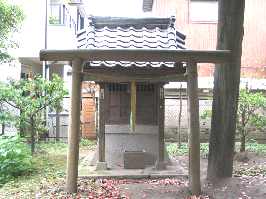
|
Yasaka Daijin Shrine
(八坂大神, or Soma Tenno 相馬天王) |
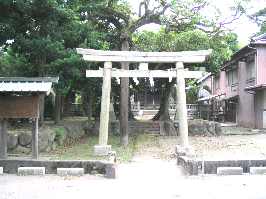
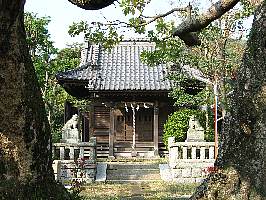
Enshrined deity: Susanoo no Mikoto (素盞嗚尊) and three other lesser gods, the tutelary deities of Ogigayatsu area.
Location: Six hundred meters from the west exit of JR Kamakura Station. History:In olden times, the shrine was dedicated to the deities of Yasaka Jinja Shrine (八坂神社) in Kyoto, brought here by Soma Morotsune (相馬師常, 1139-1205), an influential warrior in the late Heian and early Kamakura periods. Later, it was also dedicated to Morotsune himself, because he lived in this area and, together with his father, greatly helped Yoritomo in his uprising against the Taira in 1180. Morotsune afterwards came to be called Soma Tenno (天王). In the Meiji period (1868-1912), the shrine was renamed Yasaka Daijin, and dedicated to three deities, with Susanoo no Mikoto (素盞嗚尊) as the central one.
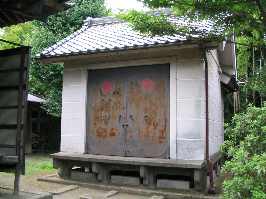
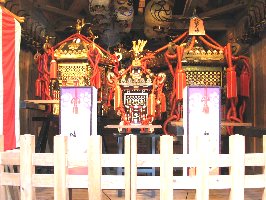
Grounds and structures: Beyond the small stream stand two ancient tabu trees (タブの木) extending their branches in all directions. The main hall is on the raised ground ahead. Two portable shrines (plus small one) are stored in a repository to the right of the main hall.
| Jufukuji Temple (寿福寺) |
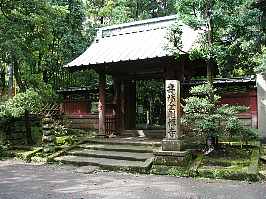
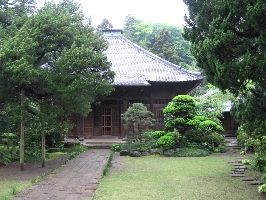
Full name: Kikokusan Jufukuji (亀谷山寿福寺)
Denomination: Rinzai sect (臨済宗)
Location: Six hundred meters from the west exit of JR Kamakura Station.
History: The grounds were once used as a residence by Minamoto no Yoshitomo (源義朝, 1123-1160), the father of Minamoto no Yoritomo (源頼朝, 1147-99), the first Kamakura shogun. Yoshitomo fought against the Heike and was defeated in Kyoto. While they were fleeing to the east, Yoshitomo was murdered, and his son Yoritomo was captured and eventually exiled to Izu. Twenty years later, Yoritomo took revenge against the Heike for his father's death. After his victory and upon entering Kamakura, he hoped to build his own residence and government offices in this area because of the connection with his father. But finding the space there inadequate, Yoritomo had his residence and the government offices constructed in Okura (大蔵), to the east of Tsurugaoka Hachimangu Shrine. After the death of Yoritomo, and in accordance with his wishes, his wife, Masako (政子, 1157-1225), had this temple built, inviting Eisai (栄西, 1141-1215) to be the founding priest. The close connection between the shogunate and the temple continued. It was said the third shogun, Minamoto no Sanetomo (源実朝, 1192-1219), often visited the temple. Because of this patronage, the temple continued to prosper. In the Muromachi period (1336-1573) it ranked third among the five Zen temples of Kamakura. At one time, the temple consisted of the seven major structures of a typical Buddhist temple, with a sammon gate (山門), a butsuden hall (仏殿, a hall dedicated to Buddha), a hatto hall (法堂, Lecture Hall), and others, plus fourteen sub-temples.
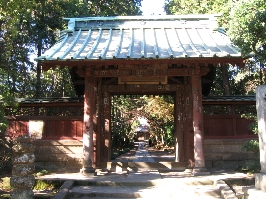
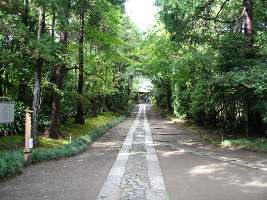
Grounds and structures: Beyond the vermilion-lacquered somon gate (総門), a straight stone walkway lined with cedars leads to the sammon gate. Behind that, ancient junipers (byakushin, 柏槙) extend their branches skyward. (The inner grounds beyond the sammon gate are not open to the public.) The temple's butsuden hall houses many treasures The object of worship in the center is the 2.8-meter seated image, Shaka Nyorai. This is called Kago Shaka (籠釈迦), literally "Basket Shakyamuni," because of its unique creation process. First, a rough shape of the statue is formed from clay and covered with layers of cloth dipped in lacquer. Second, after the layers of cloth dry, the clay inside the body is removed, leaving a hollow figure. A sculpture of this kind is light in weight in proportion to its size, but is fragile. To make up for this weakness, a frame is set inside the body. Because the frame resembles a kago (籠, a basket), this Shaka statue is called Kago Shaka. Among other temple treasures are two attendants of Shakanyorai: Monju Bosatsu (文殊菩薩) and Fugen Bosatsu (普賢菩薩). A pair of giant Nio images (仁王), brought from Hachimangu Shrine, stand with fierce-looking faces on either side of the sanctuary. Images of Eisai and Minamoto no Sanetomo are also housed there.
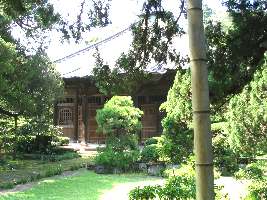
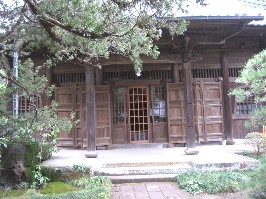
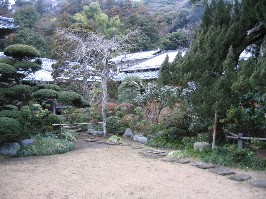
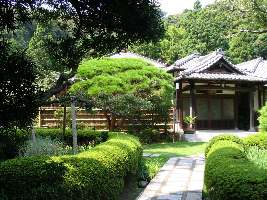
Story: Eisai, Jufukuji's founding priest, is said to have been instrumental in introducing the Rinzai school of Zen Buddhism (臨済宗) in Japan. He is also known to have brought tea plants from China and recommended the drinking of green tea for good health. Although tea was already being drunk in Japan, its consumption was limited to certain people and for medicinal purposes. It was Eisai who popularized the custom of drinking tea in much the same way that coffee or black tea is drunk in Western countries. One story has it that Eisai presented Minamoto no Sanetomo (源実朝, 1192-1219), the third shogun, with tea and an accompanying note stating its medicinal efficacy. Sanetomo was fond of drinking sake and often suffered from terrible hangovers. The Kissayojoki (喫茶養生記), Eisai's notes on the efficacy of green tea for good health, has been designated an Important Cultural Property. The book is now on loan to the Kamakura Kokuhokan, along with a seated image of Eisai himself (designated an Important Cultural Property by Kanagawa Prefecture) and a standing image of Jizo Bosatsu (地蔵菩薩), an Important Cultural Property.
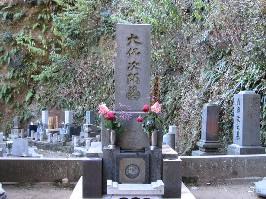
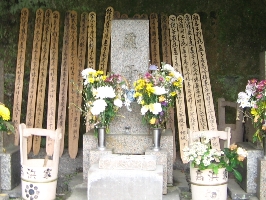
The graveyard, where many luminaries are buried, can be visited via the lane to the left of the sammon gate. The tombs include those of Mutsu Munemitsu (陸奥宗光, 1844-97), a foreign minister in the Meiji period, Takahama Kyoshi (高浜虚子, 1874-1959), a poet, and Osaragi Jiro (大仏次郎, 1897-1973), a writer, to name but a few.
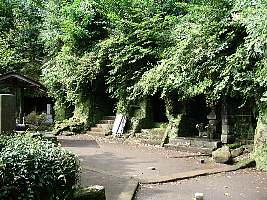
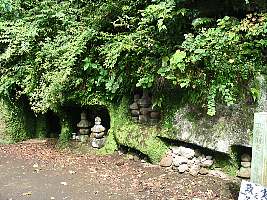
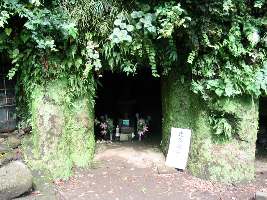
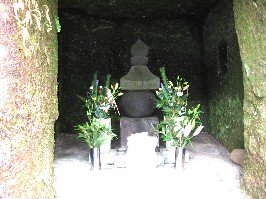
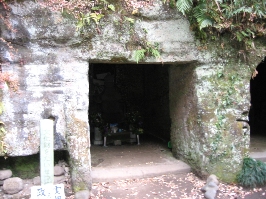
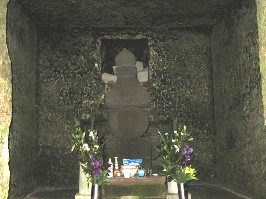 Among the many yagura, (やぐら, burial caves) in the hillside are the
graves of Minamoto no Sanetomo and his mother, Masako. The two caves
contain five-tiered gorinto-type stupas (五輪塔), said to have been
erected in their memory rather than for their remains. The cave for
Sanetomo is popularly called karakusa yagura (唐草やぐら) or ekakiyagura
(絵かきやぐら), because its walls are said to have originally been decorated with an arabesque design and colorfully painted. Masako, a daughter of
Hojo Tokimasa (北条時政, 1138-1215), married Yoritomo while he was in exile
in Izu. It is no exaggeration to say that the consolidation of the
Kamakura bakufu (幕府) government after Yoritomo's death was greatly due
to Masako's strong resolve. Another anecdote relates that after the
assassination of Sanetomo, Masako prevented a split in the government
by unifying the vassals, saying that everyone should repay the
obligation they owed to Yoritomo. Masako died in 1225 at the age of 69
and was cremated at Shochojuin Temple (勝長寿院) at Omido (大御堂) in
Yukinoshita. A record of her final resting place exists, but her actual
grave has since been lost to history.
Among the many yagura, (やぐら, burial caves) in the hillside are the
graves of Minamoto no Sanetomo and his mother, Masako. The two caves
contain five-tiered gorinto-type stupas (五輪塔), said to have been
erected in their memory rather than for their remains. The cave for
Sanetomo is popularly called karakusa yagura (唐草やぐら) or ekakiyagura
(絵かきやぐら), because its walls are said to have originally been decorated with an arabesque design and colorfully painted. Masako, a daughter of
Hojo Tokimasa (北条時政, 1138-1215), married Yoritomo while he was in exile
in Izu. It is no exaggeration to say that the consolidation of the
Kamakura bakufu (幕府) government after Yoritomo's death was greatly due
to Masako's strong resolve. Another anecdote relates that after the
assassination of Sanetomo, Masako prevented a split in the government
by unifying the vassals, saying that everyone should repay the
obligation they owed to Yoritomo. Masako died in 1225 at the age of 69
and was cremated at Shochojuin Temple (勝長寿院) at Omido (大御堂) in
Yukinoshita. A record of her final resting place exists, but her actual
grave has since been lost to history.| Eishoji Temple (英勝寺) |
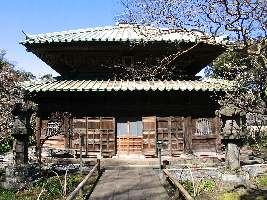
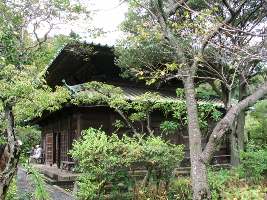
Full name: Tokozan (東光山)Eishoji (the only nunnery in present-day Kamakura)
Denomination: Jodo sect (浄土宗)
Location: A 10-minute walk north from the west exit of Kamakura Station.
History: Originally, the site was the residence of Ota Dokan (太田道灌, 1432-86), a famous warrior of the Muromachi period, who is also well known as the founder of the original Edo Castle (completed in 1457). Eishoji Temple was founded by Eishoin (英勝院), a daughter of Ota Yasusuke (太田康資, ?-?), great-great-grandson of Ota Dokan. Originally named Okaji (お梶), she was a loyal attendant, from an early age, of Tokugawa Ieyasu (徳川家康, 1542-1616), the first shogun of the Edo period. Ieyasu, in turn, trusted her highly and even gave her a new name, Okatsu (お勝), "Lady Victory," in praise of her courage when she followed him on horseback in the Battle of Sekigahara(*) in 1600. (*) The Battle of Sekigahara: The decisive battle fought at Sekigahara (now in Gifu Prefecture) in 1600 between two groups seeking hegemony over the country. One was led by Ishida Mitsunari and consisted of mainly western daimyo lords who supported the Toyotomi regime. The other was led by Tokugawa Ieyasu and consisted of mainly eastern daimyo. The victory of the Ieyasu paved the way for establishing the Edo bakufu. Okatsu later became a foster mother to Tokugawa Yorifusa (徳川頼房, 1603-61), the founder of the Mito (水戸) branch of the Tokugawa family. After Ieyasu's death, Okatsu became a nun, taking the name Eishoin. Some years later, the third shogun, Tokugawa Iemitsu (徳川家光, 1604-51), granted her this property, which her ancestors had once owned. In 1636, Eishoin had a temple built and invited Sarahime (小良姫), a daughter of Yorifusa, as its founder under her religious name of Gyokuho Seiin (玉峯清因). Because it stood on a large tract of land, the temple prospered for a long time and, for generations, women from the Mito family assumed the position of head nun.
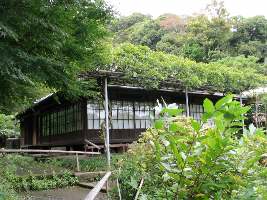
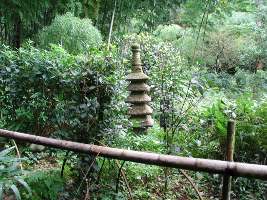
Grounds and structures: At first sight, the butsuden hall (designated an Important Cultural Property by Kanagawa Prefecture) appears to be a two-storied structure because of the second skirt-like roof around the lower section. However, the hall is actually single-storied. When attached to the lower part of a tall building, a lower roof, called mokoshi (裳階), is designed to give onlookers the impression of a well-balanced structure. Supports are under the eaves of the four sides. Each of these four struts (kaerumata 蟇股, literally, "frog-leg strut") has carvings of three animals of the Chinese zodiac, making for a total of twelve: ne (子, rat), ushi (丑, ox), tora (寅, tiger), u (卯, rabbit), tatsu (辰, dragon), mi (己, snake), uma (午, horse), hitsuji (未, sheep), saru (申, monkey), tori (酉, rooster), inu (戌, dog), and i (亥, boar). The butsuden hall houses a statue of Amida with two attendants (called Amida-sanzon, 阿弥陀三尊), a triad donated by Tokugawa Iemitsu (徳川家光, 1604-51), the third shogun, in the Edo period. The latticed ceiling has colorful paintings, accented in gold, of the Western Paradise of Buddhism: dragons, celestial maidens, musical instruments and flowers, along with crests of the Tokugawa family (three hollyhock leaves) and the Ota family (a balloon flower). Small metal cicadas are attached to the lower part of the doors. They are considered to be reminders, fitting for a nunnery, that when you enter the hall you should do so quietly so as not to surprise the small "creatures," or they symbolize a short-lived life, as that of cicadas.
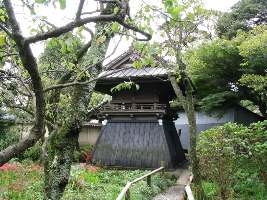
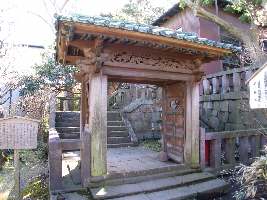
The karamon gate (唐門), next to the butsuden hall, has beams with elaborate open lattice work of peonies on both sides. This is also designated an Important Cultural Property by Kanagawa Prefecture. The shido hall (祠堂) was erected in memory of Eishoin. The hall is impressively decorated with Buddhist patterns in gold. It is also designated an Important Cultural Property by Kanagawa Prefecture. The belfry (鐘楼), next to the somon gate, has a seldom-seen structure: the lower part widens like hakama (袴), the traditional pleated trousers worn on formal occasions, which gave rise to the word hakamagoshi (袴腰) for this style of architecture. The bell was cast in 1643. The study and tea house (茶室) are on raised ground straight ahead from the entrance, past the living quarters. Tea ceremonies are often held here. A bamboo thicket borders the back hill, and there is also a small pond, surrounded by plum trees, maple and azalea.
Temple Legend: Okatsu no Kata (お勝の方) and her wit: An anecdote that reveals Eishoin's quick wit has been handed down over the centuries. One day, Tokugawa Ieyasu was having an informal conversation with his attendants and asked them what they thought was the most tasty food. They were at a loss for an answer, all except for Okatsu, who replied that it was salt. Ieyasu then asked what the worst-tasting food was. Again, she immediately answered that it, too, was salt. Everyone admired her wit.
Ota Dokan's Self-discovery: A warrior by nature, Dokan was made aware of his ignorance of literature. One story says that while he was hunting in the field, he was caught in a sudden shower. He stopped by a humble thatch-roofed house and asked the girl living there to lend him a straw cape. In place of a direct answer, she brought a stem of the Japanese rose and, without a word, offered it to him. Dokan left, puzzled. Not long afterwards, though, he came across a poem. It reminded him of the incident and the flower offered to him by the girl. That particular flower made it obvious that the girl's family was so poor that she could not even offer him a cape to keep off the rain. "The Japanese rose," says the poem, "though it blooms beautifully, produces nothing." The play on words here is that "produces nothing," can, in Japanese, also mean, "has no raincoat." Dokan, struck by his lack of learning,thereafter began to study in earnest, and eventually became a learned man.
| Memorial Stone Stupa for Abutsu
Ni (阿仏尼, Abutsu the Nun)
|
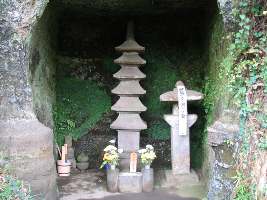 Location: A 50-meter walk north from the
rear gate of Eishoji Temple.
Location: A 50-meter walk north from the
rear gate of Eishoji Temple.History: Although this memorial stone is said to have been for Abutsu Ni (?-1283), it was probably made later. In 1279, Abutsu came alone to Kamakura from Kyoto to plead with the government on behalf of one of her sons, Reizei Tamesuke (冷泉為相, 1263-1328), a.k.a. Fujiwara no Tamesuke (藤原為相), a poet in the late Kamakura period. She kept a diary, the Izayoi Nikki (十六夜日記), "Diary of the Waning Moon," which includes her reasons and resolve for her journey to Kamakura, as well as an account of her travels and missives exchanged with her relatives and friends.
| The former site of the residence
of Ogigayatsu Uesugi (扇谷上杉氏の屋敷跡) |
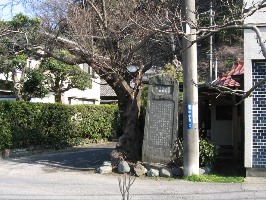
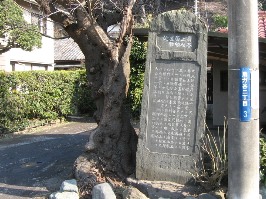
Location: About 20 meters east of Eishoji Temple.
Story: This area was once called Kanreiyashiki (管領屋敷, residence of the Kanto kanrei, a shogunal deputy of the Kanto region). In the Muromachi period, the residence of Ogigayatsu Uesugi stood here. Two families, the Ogigayatsu Uesugi in this area and Yamanouchi Uesugi (山内上杉) in Yamanouchi, were dominant in the southern part of the Kanto area, assuming the position of Kanto kanrei in turn. During the time of the sixth kanrei, Uesugi Sadamasa (上杉定正, 1443-94), this branch of the family stood at the height of its prosperity and Ota Dokan (太田道灌, 1432-86) served as chief vassal. However, in the war against the Go-Hojo of Odawara in 1546, the family was annihilated.
| Jokomyoji Temple(浄光明寺)
|
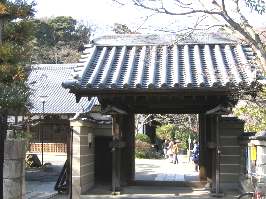
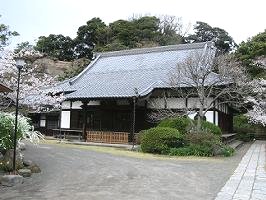
Full name: Senkokuzan (泉谷山) Jokomyoji
Denomination: Shingon sect (真言宗)
Location: Two hundred meters northeast of Eishoji Temple.
Links: Nearby there used to be the former residence of Satomi Ton (里見弴, 1888-1983), a novelist active during the Taisho and Showa periods. (The Satomi residence was demolished in 2005)
History: Although the temple looks nondescript, many historic events occurred here. According to temple tradition, Mongaku (文覚, 1139-1203), a priest, built a temple here by order of Minamoto no Yoritomo. He is said to have encouraged Yoritomo to rise against the Taira while he was in exile in Izu. Many years later, Hojo Nagatoki (北条長時, 1229-64), the sixth regent, re-established the temple with Shinsei Kokushi Shin'a (真聖国師真阿) as the founding priest. From this time the temple became a training center for various sects of Buddhism, among them, the Jodo and Shingon. In 1333, soon after the Kamakura government was destroyed, Prince Narinaga (成良親王, 1326-?, or Nariyoshi), son of Emperor Go-Daigo (後醍醐天皇, 1288-1339), came to Kamakura from Kyoto and made this temple his place of prayer. Another noteworthy event occurred in 1335. Ashikaga Takauji (足利尊氏, 1305-58), who later became the first shogun in Kyoto, confined himself here to show that he had no intention of confronting Emperor Go-Daigo (後醍醐天皇, 1288-1339). During the Muromachi period, the temple prospered under the protection of successive Kamakura kubo (公方), governor-general of the Kanto region.
Grounds and structures: Behind the sammon gate is a kyakuden (客殿) guest hall, and the kuri (庫裏) living quarters, on the left, and Fudodo hall (不動堂) on the right. The kyakuden hall has a wooden image of Aizen Myoo (愛染明王) to which prayers were made for victory over the Mongols who threatened to invade Japan in the late 13th century. Fudodo hall has a wooden image of Fudo Myoo (不動明王), which is said to have been brought by Mongaku himself from Kyoto. On raised ground stands the Main Hall, said to have been brought from Yofukuji (永福寺) in Nikaido (二階堂), and reconstructed here in the Edo period. It houses a grouping of the statues of Amida Nyorai, Shaka Nyorai, and Miroku Bosatsu (弥勒), called Sanze-Butsu (三世仏), meaning Nyorai who resided, Nyorai who resides, and Bosatsu who will reside, in the past, present and future realms, respectively. To the left of the Main Hall is a repository housing Amida-sanzon, a triad consisting of Amida Nyorai (阿弥陀如来), Kannon Bosatsu (観音菩薩), and Seishi Bosatsu (勢至菩薩), all designated Important Cultural Properties. The Amida Nyorai image was made in the Sung style (宋風) in the late Kamakura period. Solemn-looking and imposing, it is famous for the clay patterns on its robe. The Jizo Bosatsu statue on the left is called Yahiroi Jizo (矢拾い地蔵), literally, "Arrow-Gathering Jizo." This Jizo has the following legend connected with its name. The Jizo was allegedly a guardian deity of Ashikaga Tadayoshi (足利直義, 1306-52), younger brother of Ashikaga Takauji. History tells us that Tadayoshi, having run out of arrows in the battlefield, was at a loss as to what to do next. At this very moment, a child monk appeared and gathered the scattered arrows, and brought them to Tadayoshi, who was greatly surprised. Then he noticed the Jizo nearby, standing with an arrow in one hand and a staff in the other. Tadayoshi then realized that the young monk was an incarnation of Jizo, to whom he prayed daily. A close inspection of the statue here will reveal that the end of the staff in its right hand is in the shape of an arrow. This is one of the few places where such fine Buddhist images can be seen close up, so it is well worth a visit.
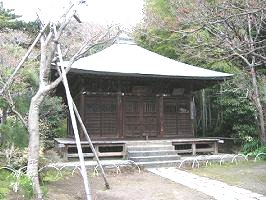
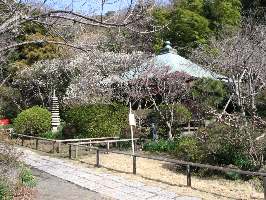
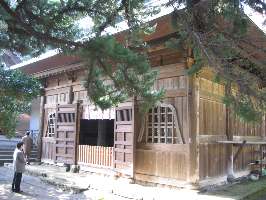
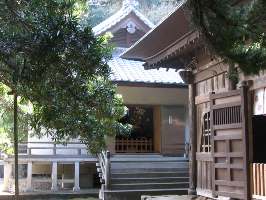
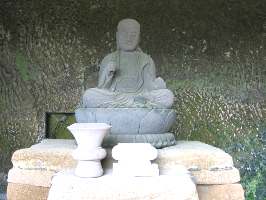
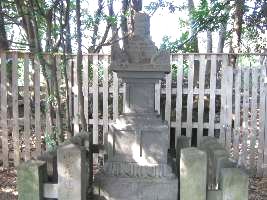
On the upper hillside behind the Main Hall is a stone Jizo bearing the inscription 正和二年 (corresponding to 1313). The statue, tradition says, was caught in a fisherman's net off Yuigahama Beach. Thus it came to be called Amihiki Jizo (網引地蔵), "Net-Caught Jizo." At the top of the hill, above the stone Jizo, is a hokyointo-type stupa (宝篋印塔) surrounded by a stone wall. This is the tomb of Reizei Tamesuke (冷泉為相, 1263-1328), designated a Historic Site by the government. Tamesuke, the grandson of the celebrated poet, Fujiwara no Teika (藤原定家, 1162-1241), is known as the founder of the Reizei family, noted for its waka poetry. When Tamesuke and his brother-in-law had a dispute over land in Kyoto, his mother, Abutsu Ni (阿仏尼, ?-1283), came to Kamakura to appeal his cause before Hojo Tokimune (北条時宗, 1251-84), the eighth regent. Later, Tamesuke came from Kyoto to visit his mother and lived at a place called Fujigayatsu (藤ケ谷), so that he came to be known as Fujigayatsu-dono (藤ケ谷殿). His mother was the author of the Izayoi Nikki (十六夜日記), a diary she kept during her trip from Kyoto and her stay in Kamakura. The footpath beyond this location is now closed to the public, making it no longer possible to see the cluster of sixteen caves at the former site of Tahoji Temple (多宝寺). There stands a 3.3-meter gorinto-type stupa (五輪塔), the second tallest in Kamakura, designated an Important Cultural Property. The stupa is that of Kakuken (覚賢), who died in 1306, and is called Kakukento (覚賢塔).
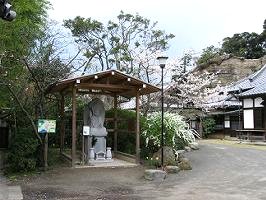
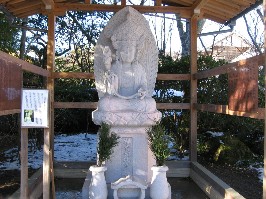
| Iwafune Jizo (岩船地蔵) |
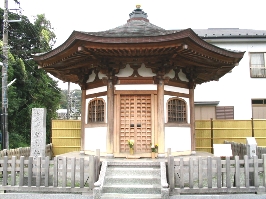 Location: Close to where the Yokosuka
Line trestle in Ogigayatsu passes near the small intersection that has
one street leading in the direction of Kamegayatsuzaka Slope and the
other in the direction of Kaizoji Temple.
Location: Close to where the Yokosuka
Line trestle in Ogigayatsu passes near the small intersection that has
one street leading in the direction of Kamegayatsuzaka Slope and the
other in the direction of Kaizoji Temple.Hall: The new structure at this corner is actually a hall for a Jizo called Iwafune Jizo and is under the care of Kaizoji Temple. The 90-centimeter wooden image of Jizo, flanked by two standing images of child-like attendants, is said to be the guardian deity of Ohime (大姫, ?-1197), the cherished daughter of Minamoto no Yoritomo (源頼朝, 1147-99).
Story: Ohime was of noble birth, but fated for an unhappy life. In 1180, when Yoritomo rose in arms against the Taira, Minamoto no Yoshinaka (源義仲, 1154-11849), a cousin of Yoritomo, also took up arms in Kiso (木曽, now in the southwest part of Nagano Prefecture) in response to Yoritomo's action. To show his loyalty to Yoritomo, Yoshinaka sent his eldest son, Yoshitaka (義高, 1173-1184), to Kamakura. This boy was supposed to marry Ohime. Yoshinaka proceeded to Kyoto by defeating the enemy. However, Yoshinaka and his men were so unruly that they lost the people's trust in Kyoto. The relationship between Yoritomo and Yoshinaka then seriously deteriorated, and led to war between the two. Eventually Yoshinaka was defeated and killed at the hands of Yoritomo's warriors. Soon after that, Yoritomo waited for a chance to kill Yoshinaka's son, Yoshitaka. A story goes on that upon sensing this, Ohime arranged for her young fiance to return to his home. Disguised as a girl, he departed on horseback, with the hooves of his horse wrapped with cotton to cover their sound. A few days later, Yoshitaka was discovered and eventually beheaded. Ohime was six and Yoshitaka, twelve. This turn of events apparently affected Ohime so deeply that she died before attaining the age of 20, after a long-lasting siege of mental problems.
| yakuoji Temple (薬王寺) |
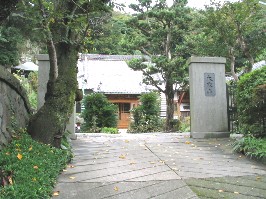
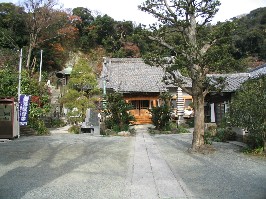
Full name: Daijozan (大乗山) yakuoji
Denomination: Nichiren sect (日蓮宗)
Location: One kilometer north of JR Kamakura Station.
History: The original temple belonged to the Shingon sect, but this was changed to the Nichiren sect by Nichizo (日像), who resided here in 1293. He was a leading disciple of Nichiro (日朗). Further, in the early Edo period, the priest, Nittatsu (日達), reconstructed the temple under a new name, yakuoji (薬王寺). The temple had a close relationship to the Tokugawa shoguns in the early Edo period. The story goes that Tokugawa Tadanaga (徳川忠長, 1606-34), the third son of the second shogun, Tokugawa Hidetada (徳川秀忠, 1579-1632), committed suicide because he was suspected of having plotted against the shogun. Soon after, his wife, Shokoin (松孝院), had his tomb built here. She was the daughter of Oda Nobukatsu (織田信雄, 1558-1630), the second son of Oda Nobunaga (織田信長, 1534-82). (Nobunaga was the first leader to unify Japan, ending the Warring States Period (1467-1590).) The tragic event of Tadanaga's suicide originated from the issue of the shogun's succession. The second shogun, Hidetada, favored Tadanaga, who was said to be highly intelligent and naturally expected to succeed his father. However, through maneuvers by various people, Tadanaga's older brother, Iemitsu (徳川家光, 1604-51), became shogun. Tadanaga, meanwhile, lost hope and forced into committing suicide. Because of donations made by his wife, Shokoin, and others, the temple was prosperous. Much later, in the Meiji period, the temple lost patronage due to the anti-Buddhist movement and was abandoned. But, the 50th priest, Nisshin (日振), restored it in 1923. Most of the structural materials of the hall, except the refurbished roof, remain just as they were in 1727, allowing the building to retain the atmosphere of the Edo period.
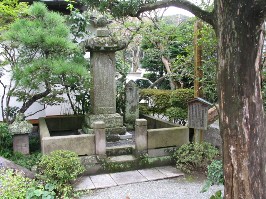
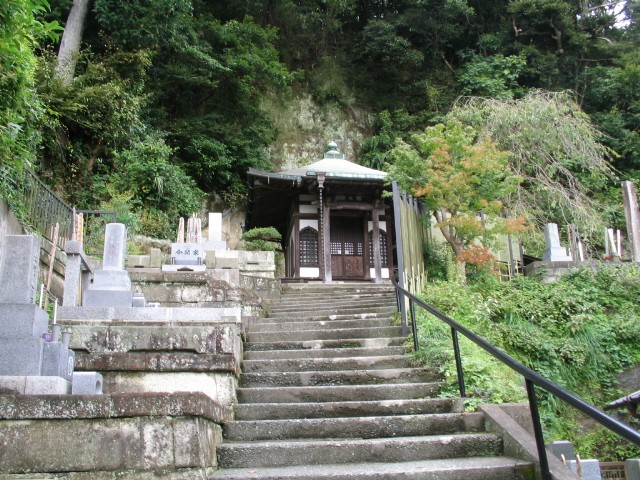
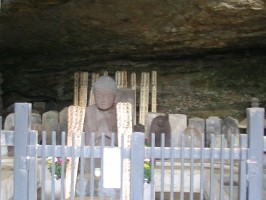
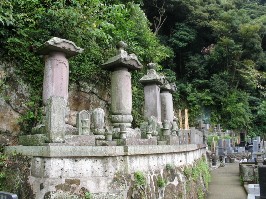
Grounds and structures: Within the grounds are a belfry to the left, the main hall ahead, and the kuri living quarters of the priest, to the right. In front of the kuri is an imposing tombstone for the above-mentioned Tokugawa Tadanaga. There is also a stone slab next to the tombstone, inscribed with a passage from a sutra and the year name元弘二年, (corresponding to 1332). In the main hall are an image of Nichiren in the center, one of Daikoku Ten (大黒天) in front, a statue of Nichizo, the founding priest, to the right, an 80-centimeter Bato Kannon (馬頭観音), and a 90-centimeter Kanzeon Bosatsu (観世音菩薩) further to the right. The image of Nichiren is large-scale and very rare, with an open mouth revealing teeth and tongue. The upper half of the image was carved as a naked body and is draped with a robe. To the left of the main hall is a flight of stone steps leading to the back hill of the temple. At the top is Shakado Hall (釈迦堂), reconstructed in 1930. It houses a wooden image of Shaka Nyorai (釈迦如来). At the center of the hillside graveyard are two, three-meter-high hokyointo-type stupas. Both were erected in the Genroku era (元禄, 1688-1704) and dedicated to the wife and daughter of Gamo Tadachika (蒲生忠知, 1605-34), the Lord of Matsuyama Castle (松山城, now in Ehime Prefecture). Tadachika was the grandson of Gamo Ujisato (蒲生氏郷, 1556-1595) of Aizuwakamatsu (会津若松, now in Fukushima Prefecture). Ujisato, a major daimyo, or feudal lord, of the Azuchi-Momoyama period (1573-1603), served both Oda Nobunaga and Toyotomi Hideyoshi (豊臣秀吉, 1537-98), and became the Lord of Aizuwakamatsu Castle. He was a man of culture, skilled in poetry and the tea ceremony. He was also a believer in Christianity until Hideyoshi's anti-Christian edicts took effect in 1587.